For various reasons, cucumbers sometimes simply die. Read here what causes are often behind it and what measures can be taken against it. This is how you can save your cucumbers.
- Cucumber plants are sensitive plants
- mostly external influences responsible for dieback
- rarely care errors
- know causes and take measures
- in many cases it is possible to save the cucumbers
Contents
- 1 Cucumbers die: Causes
- 2 Exhaustion
- 3 Prepare and apply horsetail broth
- 4 Blossom end rot
- 5 Anthracnose
- 6 Angular leaf spot disease
- 7 Fusarium wilt
- 8 Severe temperature fluctuations
- 9 Water shortage
- 10 Frequently asked questions
- 11 Can cucumber aphids cause cucumbers to die?
- 12 How to tell when a Cucumis sativus is about to die?
- 13 Are cucumbers still edible if they do not show direct infestation?
- 14 Author
Cucumbers die: Causes
If your cucumbers suddenly die, there are several possible causes:
Exhaustion
The sudden death of cucumbers may be due to a state of exhaustion. Usually young plants are affected, in which an undersupply leads to exhaustion at the latest after the second cucumber is ready for harvest. This is due to the supply channels not yet fully developed, as well as too low capacity of the nutrient store.
Typical damage pattern
- Growth disorders
- Loss of stability due to lack of energy
- Stunting of the green and the fruit
- Drying out
Countermeasures
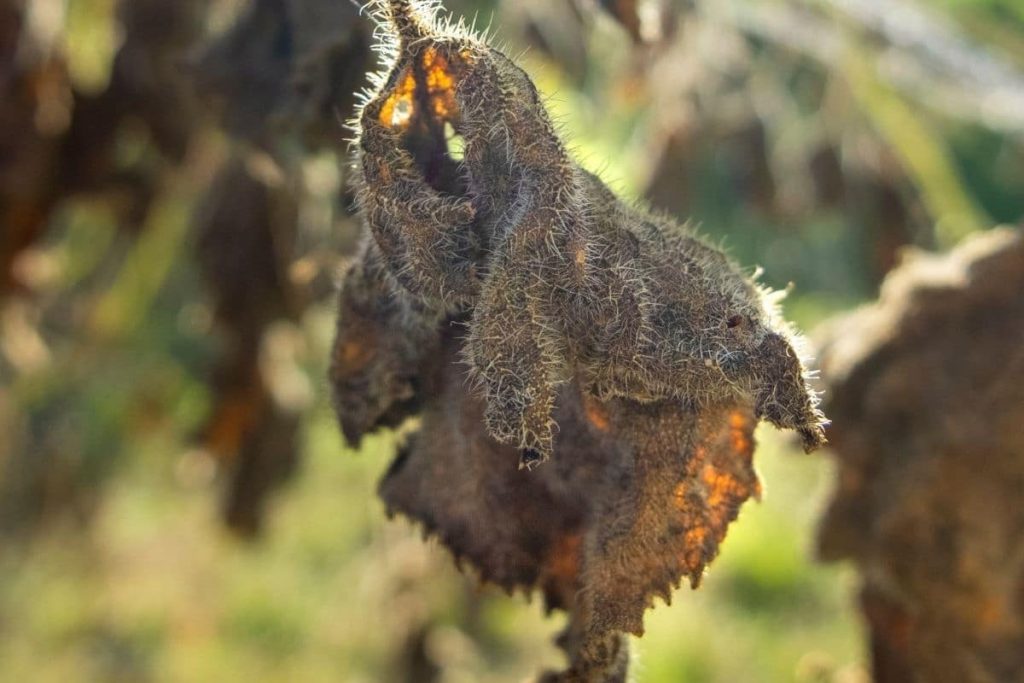
- cut off withered leaves as soon as possible (unnecessarily draw nutrients further)
- administer vegetable fertilizer
- water with field horsetail broth for strengthening
Prepare and apply horsetail broth
- Add 1 to 1.5 kilograms of fresh, finely chopped or 150 to 200 grams of dried field horsetail to ten liters of water.
- leave to infuse for 24 hours
- bring the broth to a boil and boil for 30 minutes
- let it cool down and sieve out the remains of the stalks
- Pour the broth on plants
- repeat every two to three days for two weeks
Prevention
- delay fruit growth in the first two years of life
- in case of simultaneous fruit growth on neighboring leaf axils, remove all but one of them
- fertilize regularly with nutrients
- pay attention to ideal soil properties
Blossom end rot
Blossom end rot is usually caused by a calcium deficiency.
Typical damage pattern
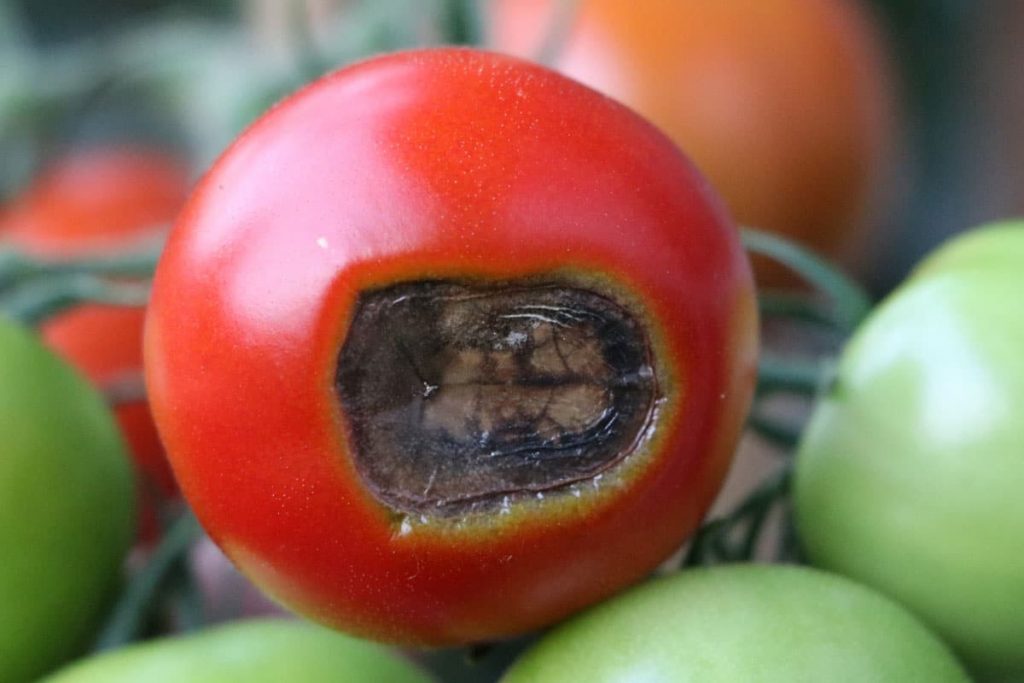
- small, watery spots at the base of flowers
- visible rot spreading on fruits (mostly affected ones in early ripening stage)
- increasingly larger black-brown spots on affected cucumber (sunken)
- fruits dry out and harden
Countermeasures
First, the soil should be checked for pH. If this is below 6.0, algal lime should be worked into the soil in the event of an acute infestation. So that it dissolves quickly, it should then be watered. If the pH value is in the ideal range, too high a salt content in the soil may be the cause. Overfertilization is often to blame here. Salt prevents the plant from absorbing calcium. In that case, the best remedy is to completely replace the soil with fresh soil to lower the fertilizer content. Areas severely affected by rot should be cut off. Act quickly and consistently, your cucumbers will not necessarily die.
Tip: Disposable tests to determine ph are available at garden supply stores and most well-stocked hardware stores. If you like to garden a lot, you should always have these at home to have them quickly at hand when needed.
Prevention
The best countermeasure is prevention. This looks as follows:
- follow the manufacturer’s instructions for dosage or use a lower dosage
- water evenly and regularly and avoid too much and too little humidity
- pay attention to air permeability so that high humidity does not occur
- provide loose, water-permeable soil
Anthracnose
Anthracnose is a widespread disease caused by a fungal pathogen (Colletotricum lupini). If you do not pay close attention to the symptoms, you can quickly confuse the fungal disease with blossom end rot and the associated calcium deficiency. Here, too, it is important to act quickly, otherwise the cucumbers will die.
Typical damage pattern
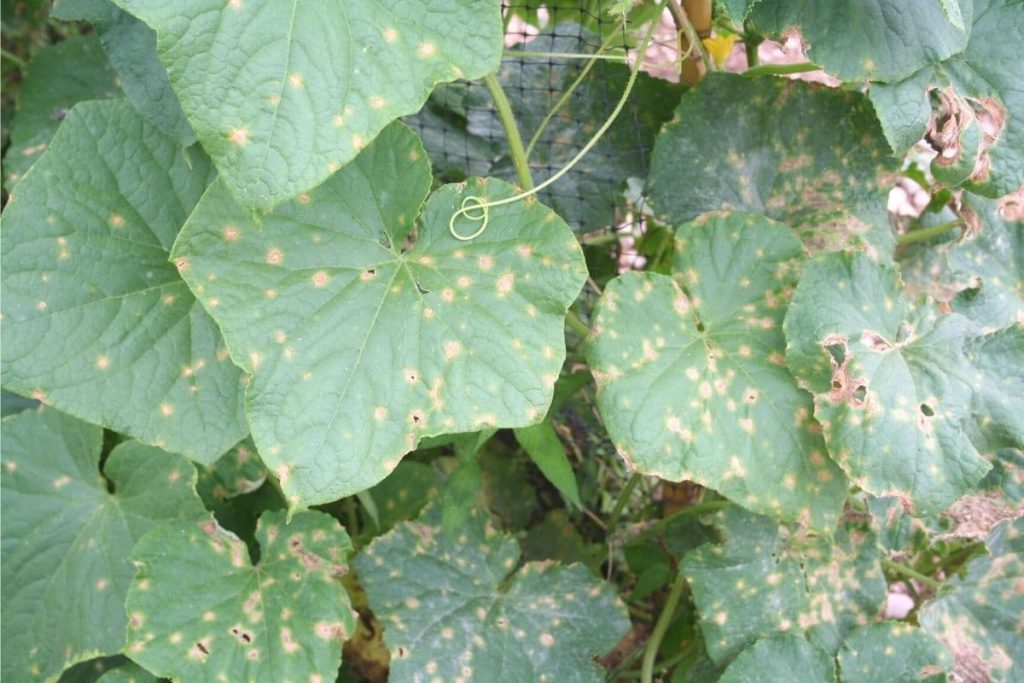
- dark gray to brown, sunken burn marks (lesions) on fruit
- dark spots in dry ambient air, formation of salmon-colored spore carpet in moist ambient air
- dropping fruit tissue in later stages
- fruits dry out
- fruit set withers and dries up
- shriveling of cucumbers in the early stage of ripening
- small light spots on leaves
- withering of the entire plant in the final stage
Countermeasures
- cut off affected parts of the plant immediately and dispose of in organic waste
- disinfect the cutting tools afterwards
- Place the plant in a cooler place (ideally at 21 degrees Celsius)
- Pour field horsetail decoction to strengthen the plant (for preparation and application, see “Exhaustion – What to do about it”).
Tip: Never dispose of plant parts with bacterial, viral or fungal pathogens in the compost. In the open air, these can continue to spread undisturbed. They should always be disposed of under lock and key.
Angular leaf spot disease
The bacterium Xanthomonas fragariae causes angular leaf spot disease, which is common on garden cucumbers. The bacterium does not form spores and is rod-shaped. Because it not only attacks the leaves or outer parts of the plant, but also gets into the interior of the plant, rapid death of the cucumbers is possible if measures against it are not taken in time.
Typical damage pattern
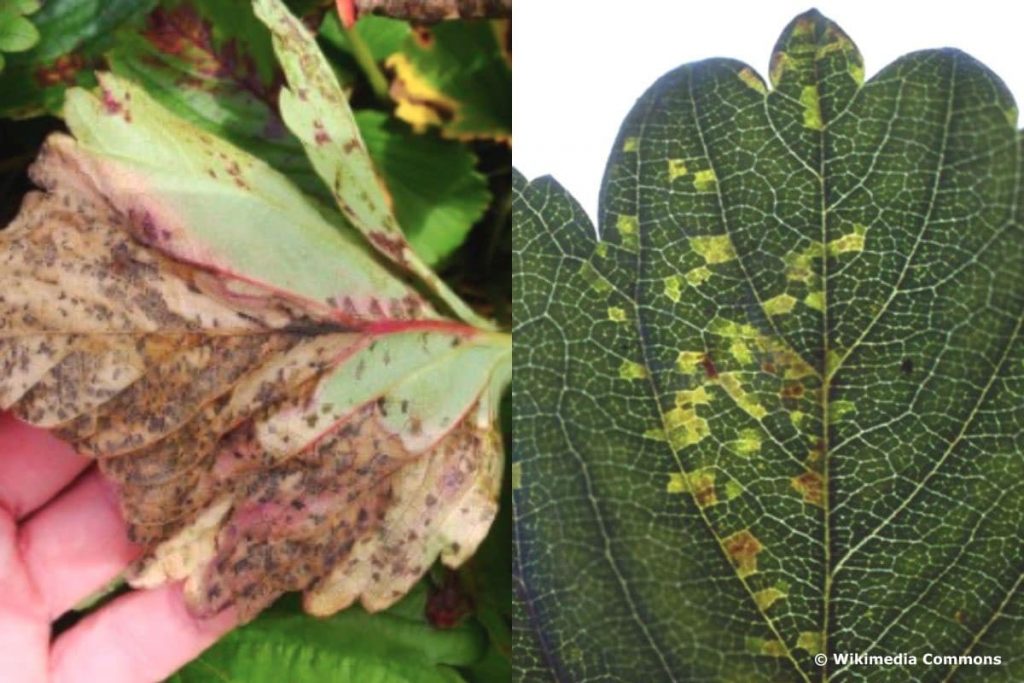
- small, watery burn spots on undersides of leaves
- spot enlargement into angular shapes with increasing progression
- in humid environment formation of a viscous bacterial slime
- spot color: greenish, later brown
Countermeasures
Regardless of when the bacterial infection is discovered and identified as such, help is unfortunately not available in this case. The entire plant should be disposed of in household or organic waste. No more cucurbits, which include cucumbers, should be grown at the same planting site for a period of at least three years.
Prevention
Not much can be done to prevent leaf spot disease. Experts suggest that a high warm-humidity constellation promotes the disease, so an airy location can easily reduce the risk. Avoiding monoculture and constant crop rotation also reduces the risk.
Fusarium wilt
Fusarium wilt often occurs in cucumber plants. Here, the fungus Fusarium oxysporum colonizes the plant and provides an easily recognizable pattern of damage.
Typical damage pattern
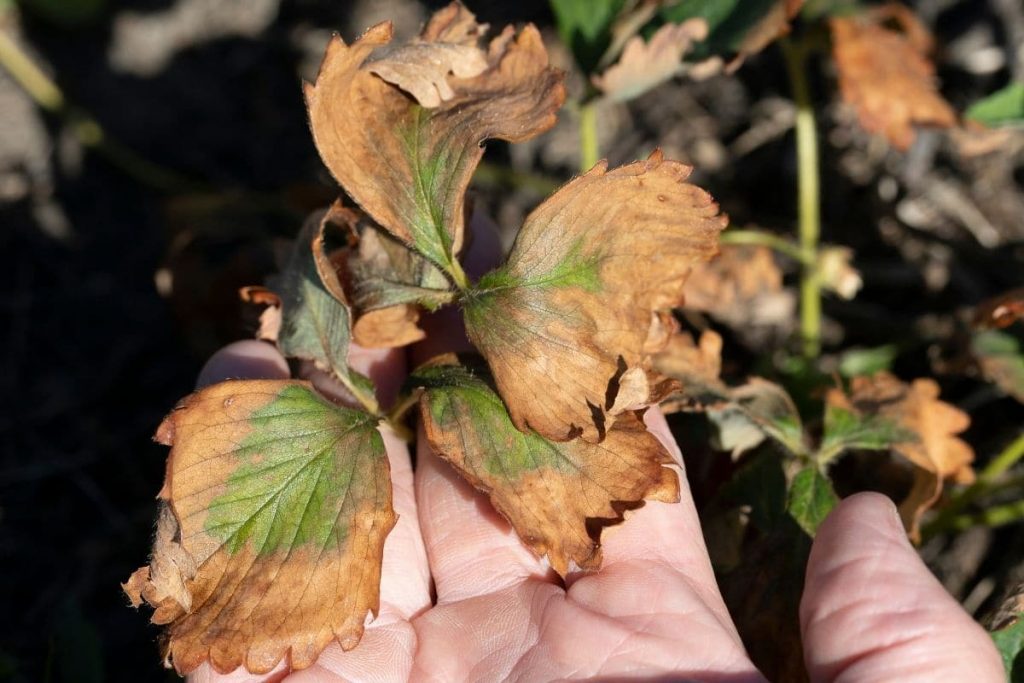
- rapid, premature flower wilt
- buds do not open
- slowly progressing brown leaf coloration
- increasing withering
- growth disturbances
- brown-black discoloration of fruits before they dry out
- complete withering of the plant
Countermeasures
Nothing. There are no known effective measures against Fusarium wilt that could stop the cucumbers from dying. Disposal is inevitable.
Prevention
- Strengthen resistance with pesticides (for example, water regularly with field horsetail broth).
- lay drainages (to avoid waterlogging)
- use only disinfected cutting tools
- avoid monoculture
Severe temperature fluctuations
If there are significant temperature fluctuations and it cools down sharply in between, this can have a negative effect on cucumber plants. In the worst case your cucumbers will die here too
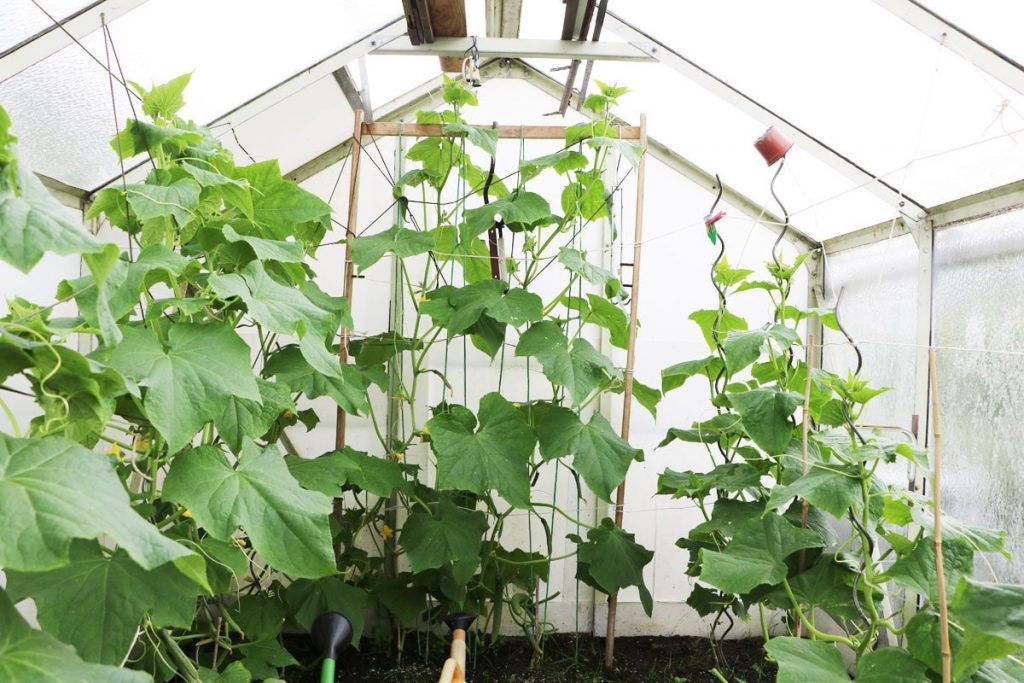
Typical damage pattern
- stunted cucumber forms
- dried up young fruits
- premature fruit drop of immature cucumbers
Countermeasures
In the case of damage caused by severe temperature fluctuations, there is nothing to do but throw away the affected fruit.
Prevention
As a preventive measure, cucumber plants can be planted in a wind-protected location, but this favors infestation with leaf spot disease. Checking the weather forecast is recommended to protect the plants in time with cold protection, such as fleece, in case of a sharp drop in temperature.
Water shortage
If your cucumbers die, a lack of water is often the reason. This is clearly a care error, which is easy to prevent. If detected in time, the plant can be helped quickly.
Typical damage pattern
- Plant loses stability
- Further symptoms as described under “Severe temperature fluctuations
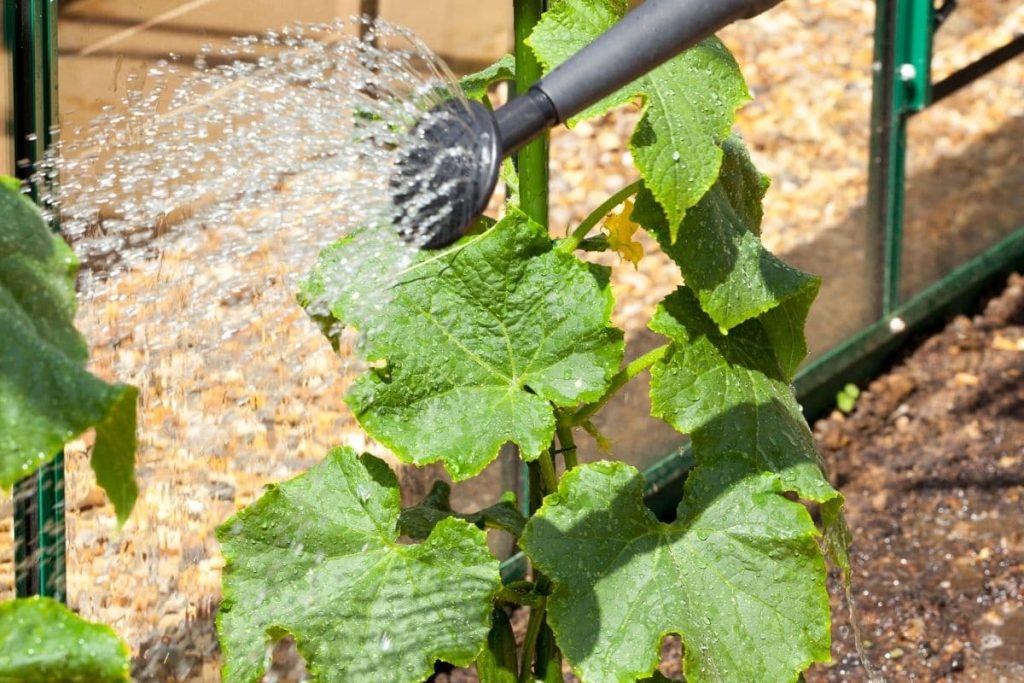
Countermeasures
- water immediately
- cut off dried up parts of the plant
- Prevention
The only preventive measure is regular watering and checking soil moisture twice a day, especially on hot summer days.
Frequently asked questions
Can cucumber aphids cause cucumbers to die?
As a rule, no. Aphids are parasitic pests, but if they infest healthy and vigorous cucumber plants, a life-threatening situation does not normally result.
How to tell when a Cucumis sativus is about to die?
The more cells die, the less photosynthesis works. If more than 3/4 of the cucumber plant has dried up, the dieback is usually almost impossible to stop.
Are cucumbers still edible if they do not show direct infestation?
In the case of the above causes, consumption is not advisable. In almost every case, negative effects on the fruit are to be expected. Especially in the case of fungal and bacterial infestation, consumption should be avoided because damage to health can result. Exceptions are, of course, temperature fluctuations and lack of water, although even then developmental disorders cause changes in consistency, flavor and degree of ripeness.









